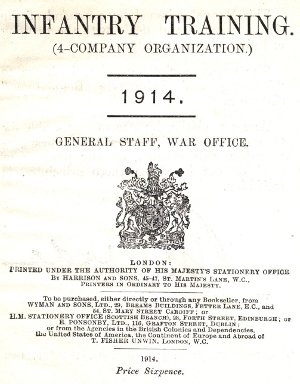Topic: Drill and Training
 Infantry Training, 1914
Infantry Training, 1914
Chapter II – Squad Drill
10. Method of instructing recruits.
 1. The instructor should be clear, firm, concise, and patient; he must make allowance for the different capacities of the men, and avoid discouraging nervous recruits; he must remember that much may be taught by personal example, and that careful individual instruction is the best means of developing the intelligence.
1. The instructor should be clear, firm, concise, and patient; he must make allowance for the different capacities of the men, and avoid discouraging nervous recruits; he must remember that much may be taught by personal example, and that careful individual instruction is the best means of developing the intelligence.
2. The instructor will teach as much as possible by demonstration, performing the movements himself or making a smart recruit perform them. the detail for each movement as given in this manual is for the information of the instructor, who must avoid repeating it word for word because such a method is wearisome and monotonous and would not be understood by some recruits.
The instructor will explain the reason for every movement and formation, and its application in the field.
3. Drills will be short and frequent to avoid the exhaustion of the instructor and recruit.
4. Recruits will be advanced progressively from one exercise to another, men of inferior quality being out back to a less advanced squad.
5. At first the recruit will be placed in a position by the instructor; afterwards he should not be touched, but made to correct his own position when faults are pointed out.
11. Words of Command
 1. Commands will be pronounced distinctly, and sufficiently loud to be heard by all concerned.
1. Commands will be pronounced distinctly, and sufficiently loud to be heard by all concerned.
2. Commands which consist of one word will be preceded by a caution. The caution or cautionary part of a command, will be given deliberately and distinctly; the last or executive part, which, as a rule, should consist of only one word or syllable, will be given sharply: Bat-ta-lion—HALT; Right—FORM; Right hand—SALUTE. A pause will be made between the caution and the executive word of command.
3. When the formation is moving, executive words will be completed as the men begin the pace which will bring them to the spot on which the command is to be executed. The caution must be commenced accordingly.
4. Young officers and non-commissioned officers will be frequently practiced in giving words of command.
5. Indistinct and slovenly words of command beget slovenly movements and must be avoided.
6. The cautions and commands in this manual are, as a rule, given with regard to one flank only, but the same principle applies equally to movements to the other flank, which will also be practiced.

